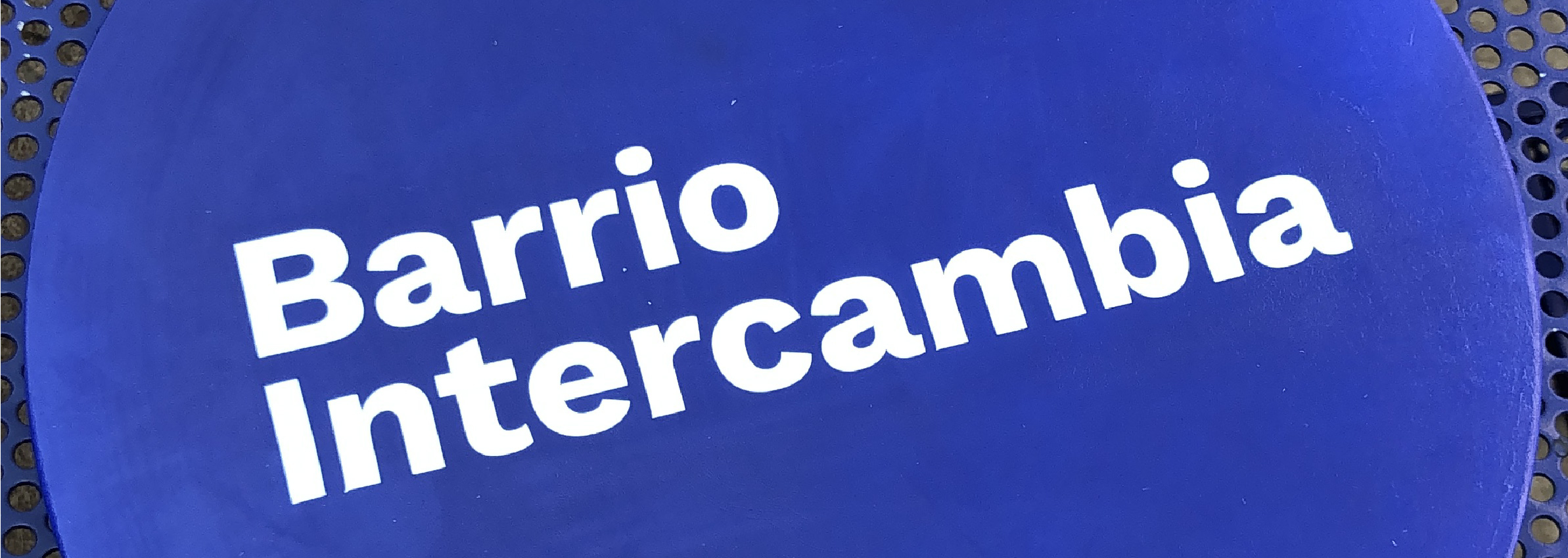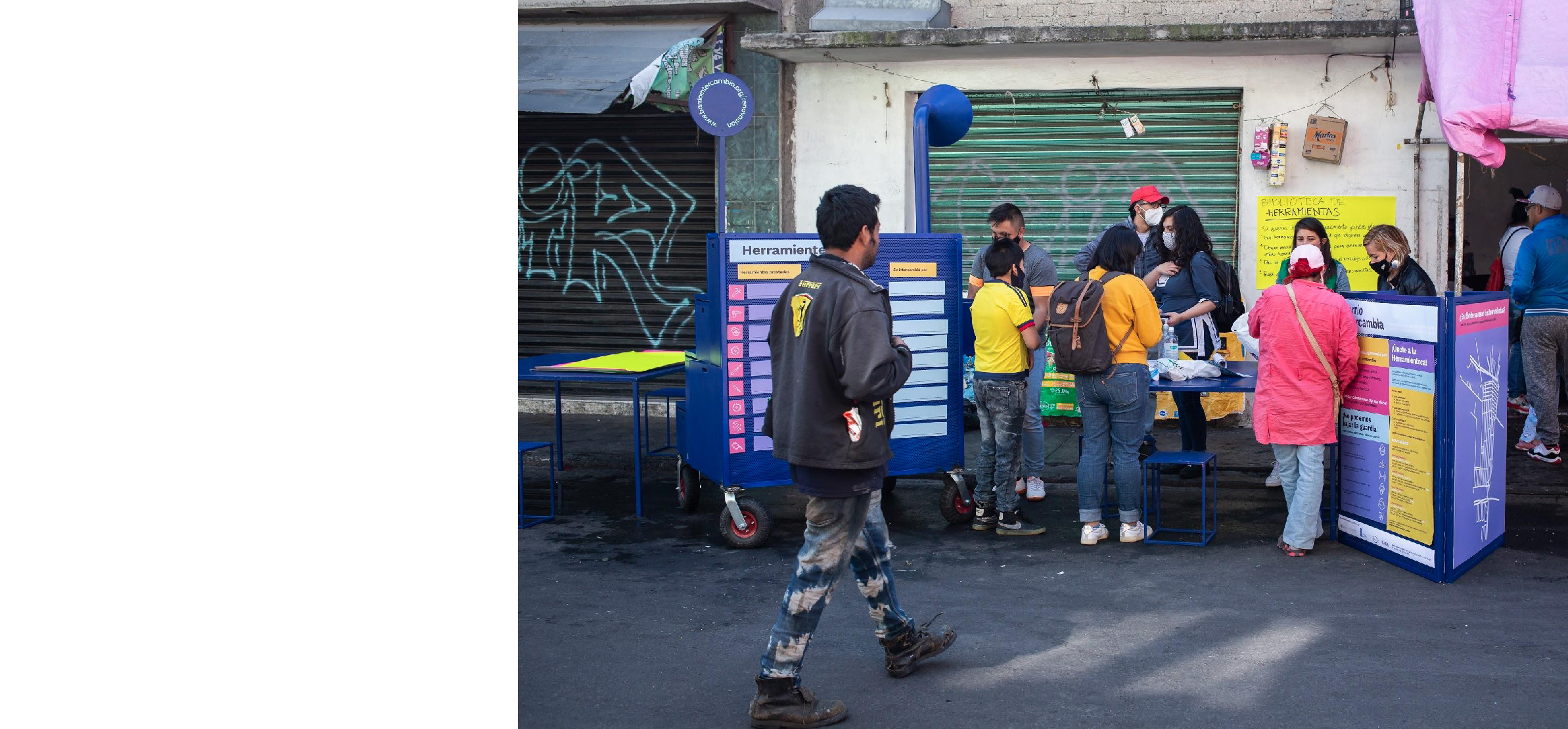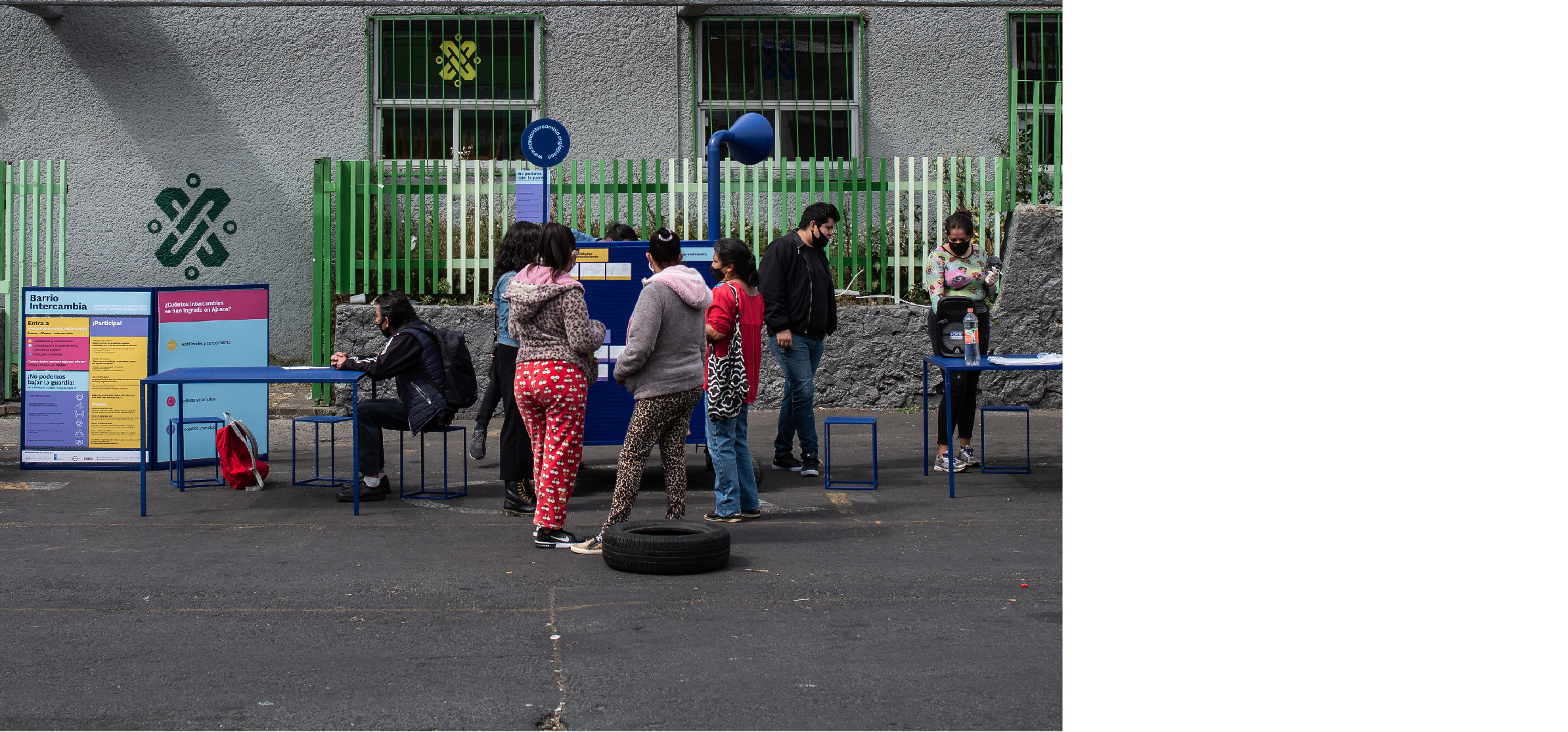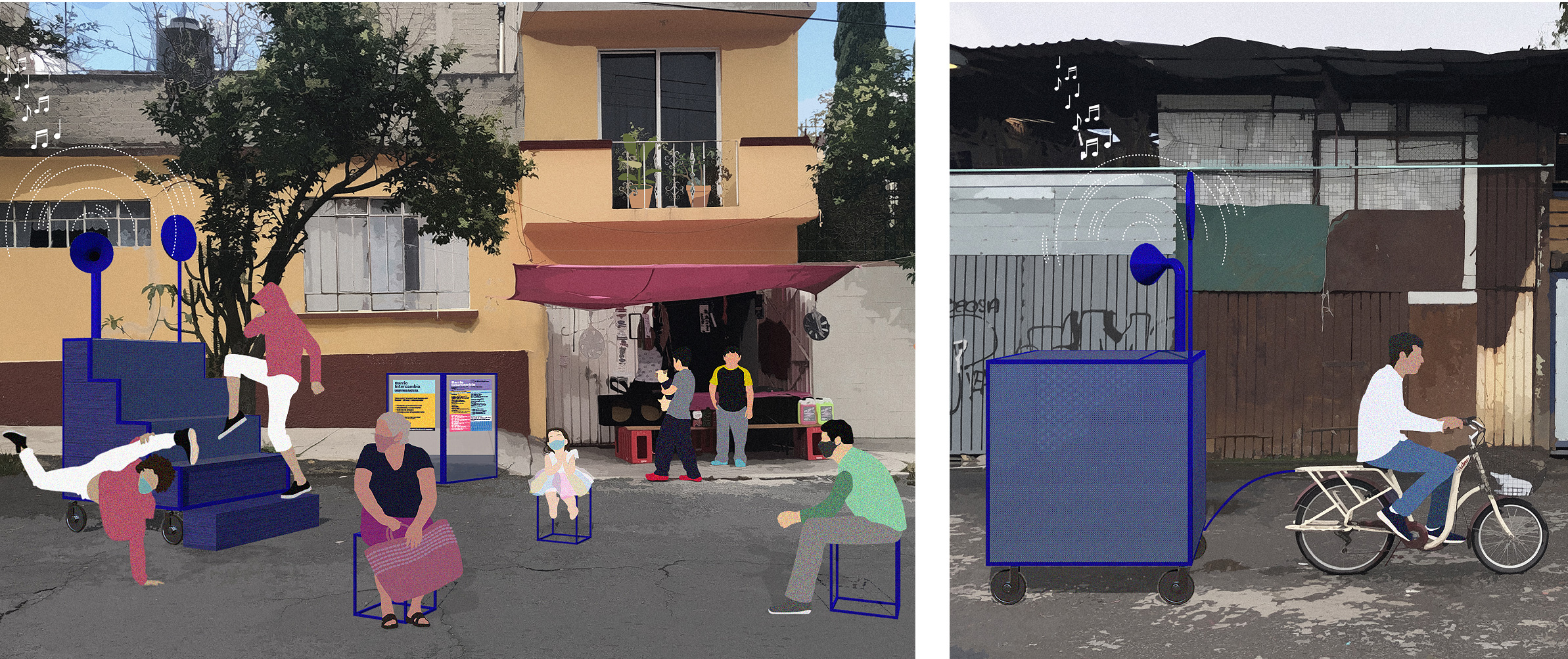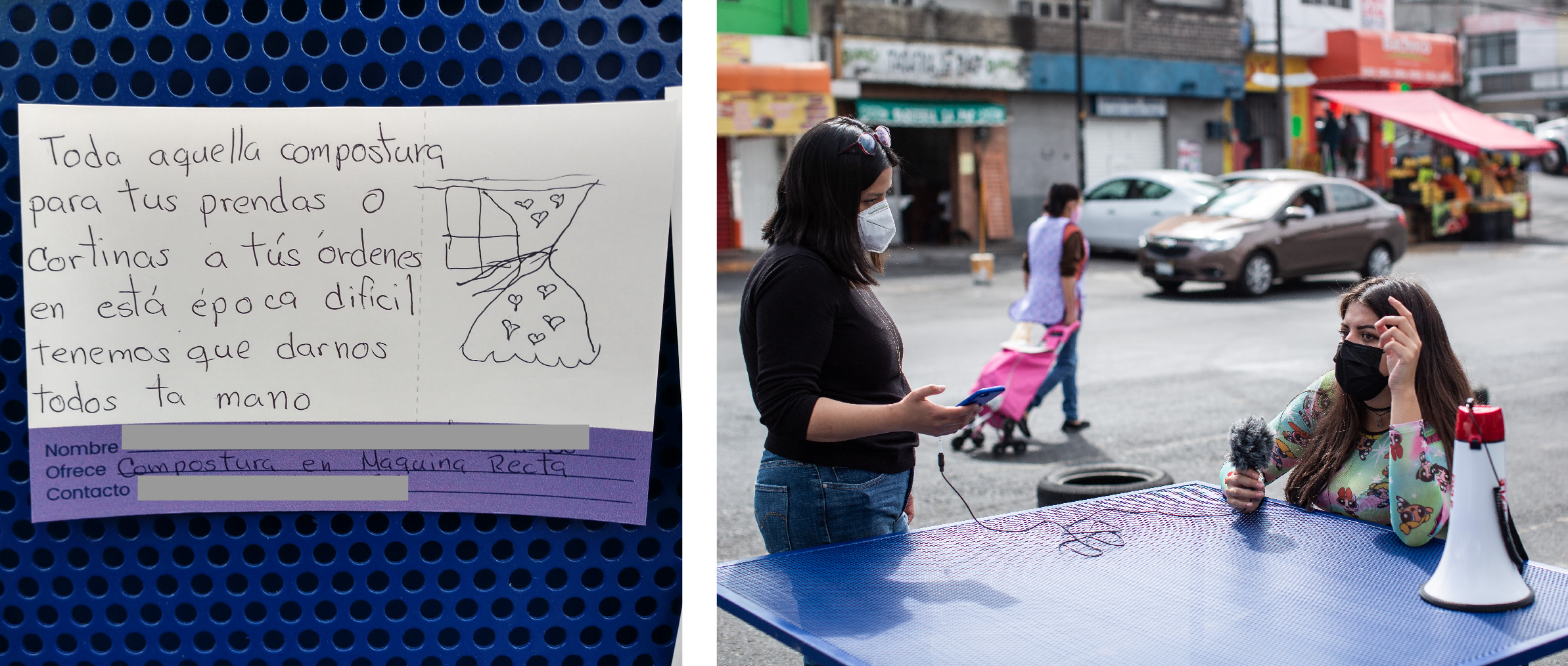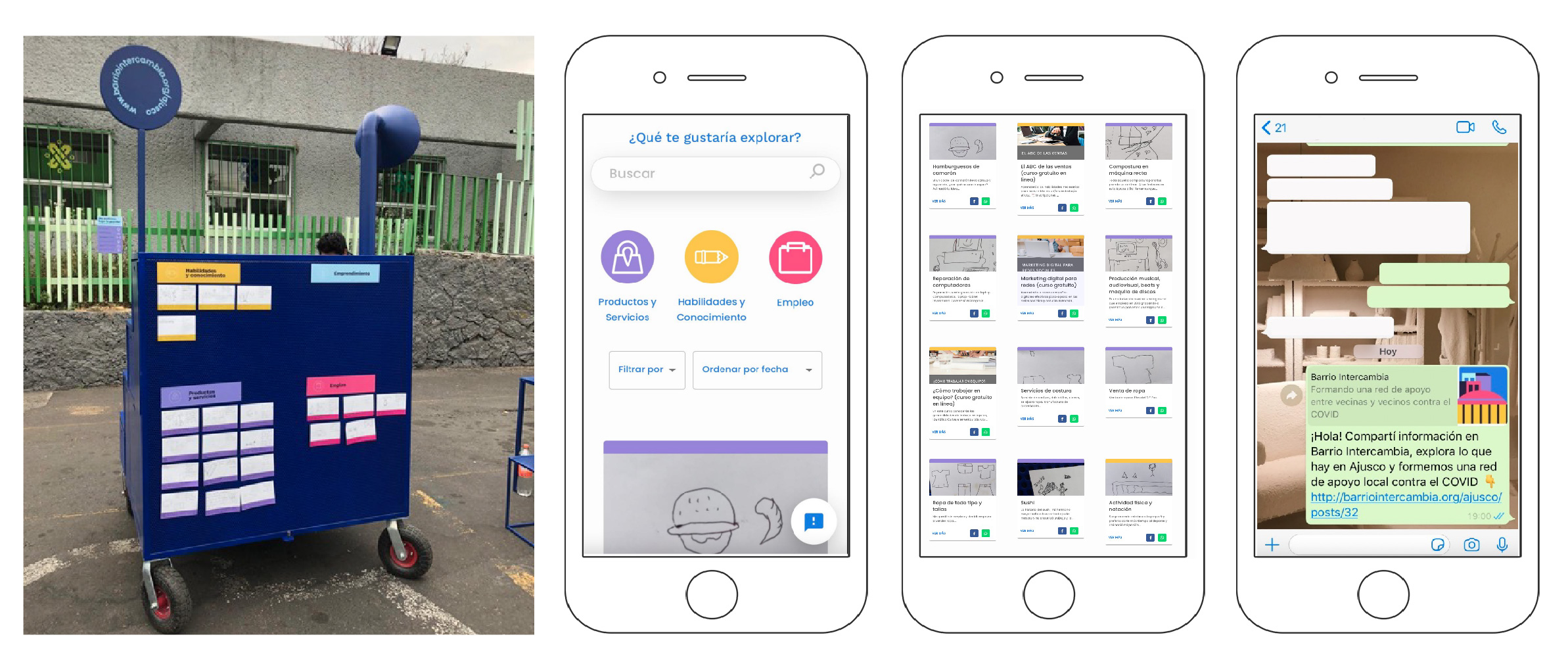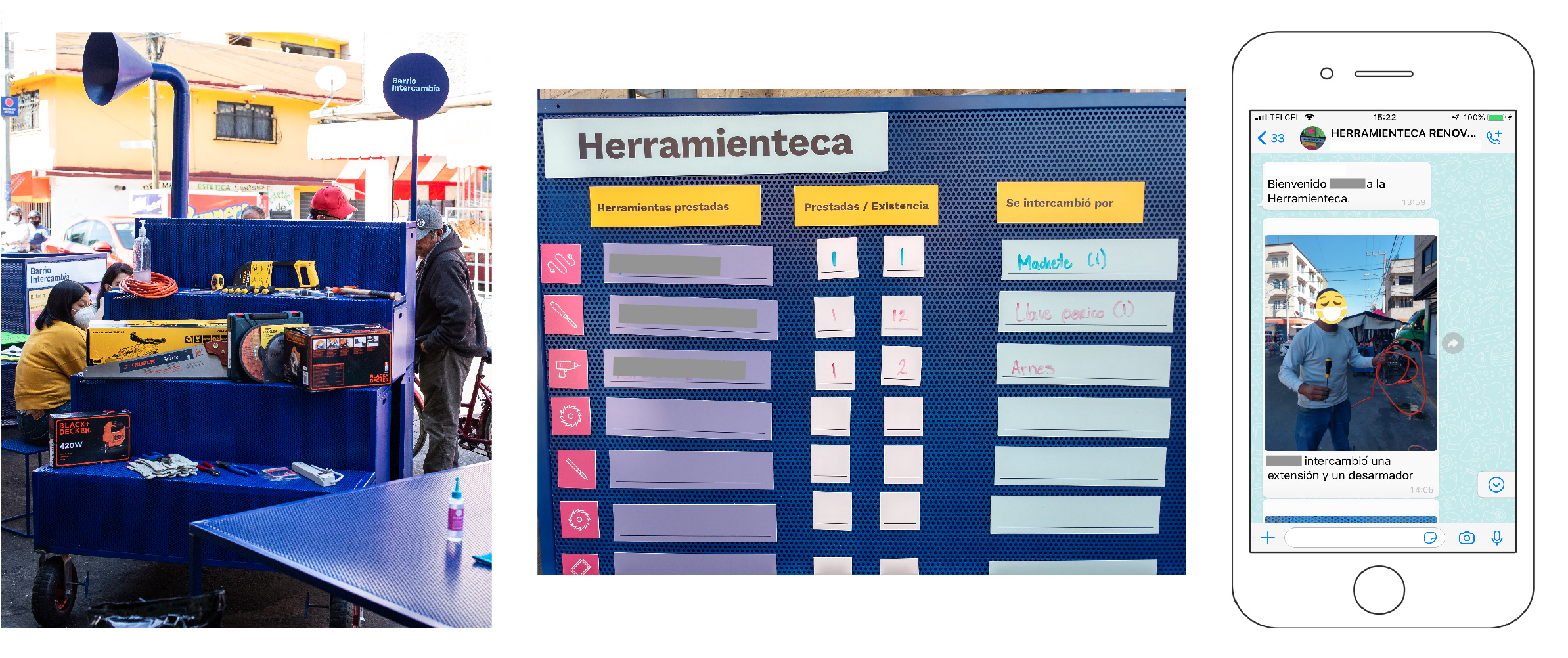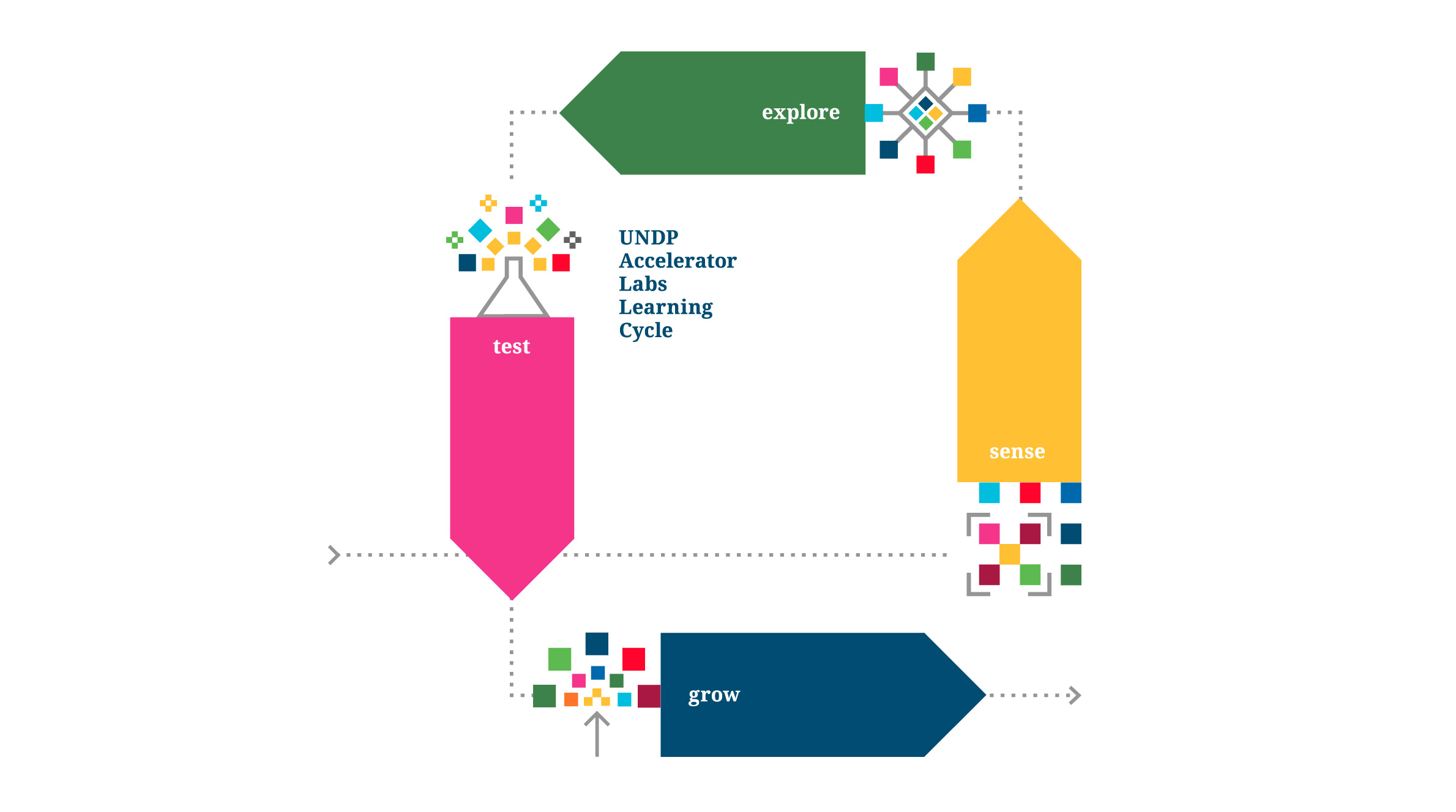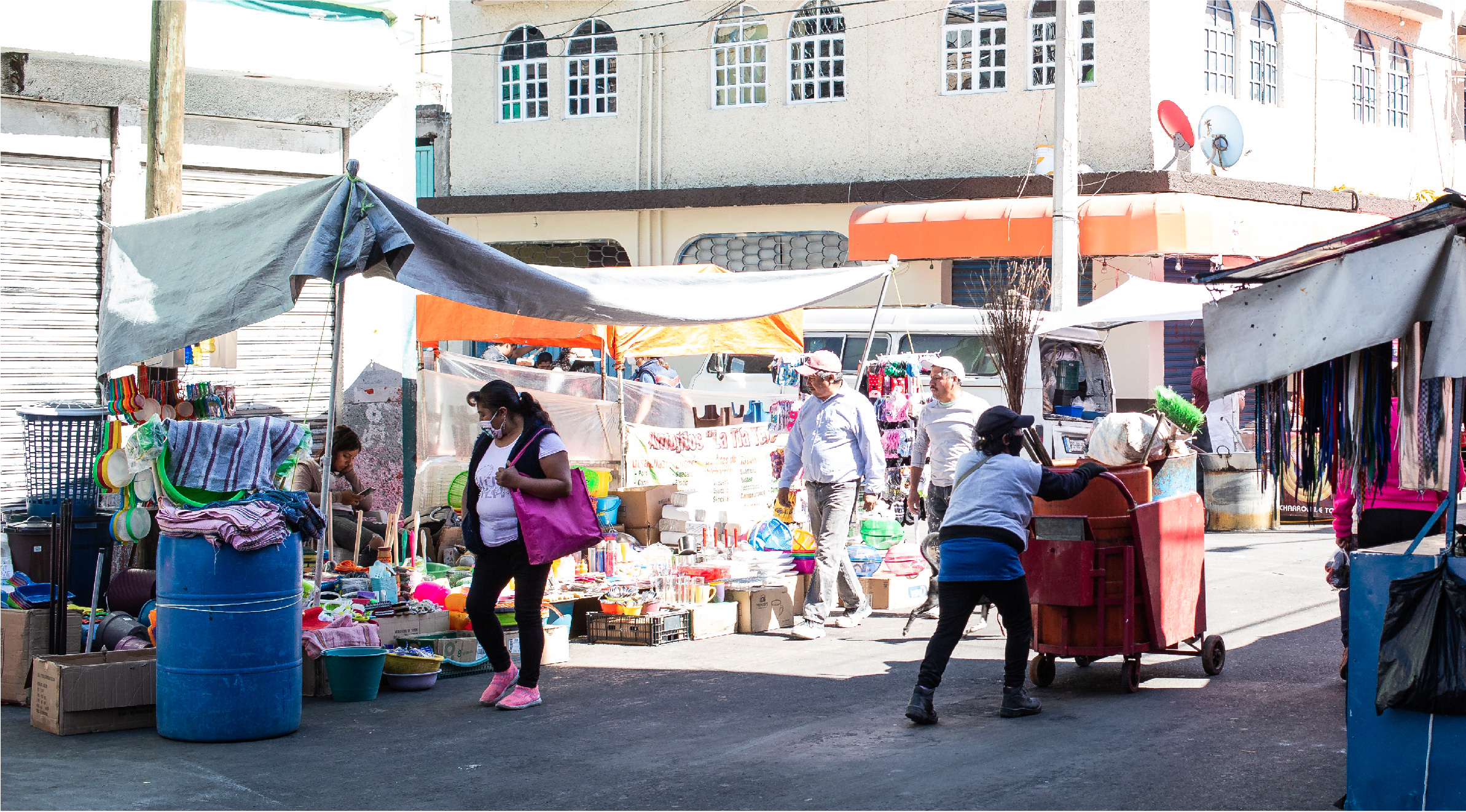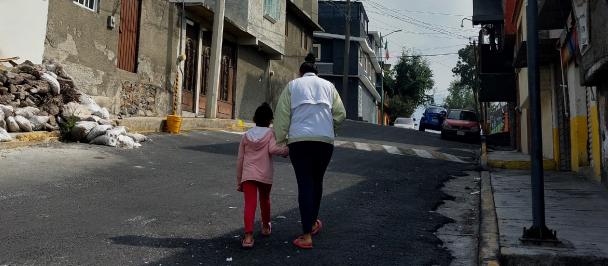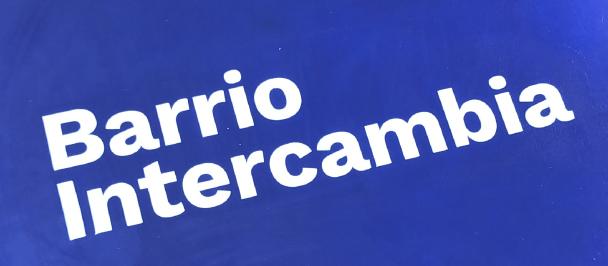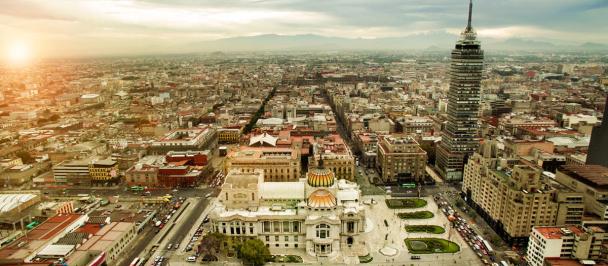Series "Barrio Intercambia: local support, social ties and community resilience" (Part 1)
More local exchanges, more social ties
13 de Enero de 2022
One Monday morning, Javier was walking through his neighborhood when he saw a group of people in the street standing around a blue stand with tools. They were announcing a "Herramienteca." “What is that?” - he thought. He approached them to ask and one of the organizers replied: “It's like a library but with tools. You can borrow a tool for a day and, in exchange, you can either leave a tool of yours, so that a neighbor can borrow it, or give someone advice on how to use it."
In another neighborhood, María was walking and saw a group of people who were inviting neighbors to participate in an activity to share their stories. She saw a young man sitting on a blue bench writing something on a card and a woman talking to one of the organizers, who was recording her. When she got closer to the stand, she saw some signs that said, "Products and Services", "Skills and Knowledge", "Entrepreneurship", "Employment".
Javier and María live in Mexico City. He lives in Renovación, a neighborhood in the Iztapalapa borough, and she lives in Ajusco, in the Coyoacan borough. These are not their real names, we changed them to protect their privacy. What is real is the anecdote. The tool library, the story-sharing activity, and the blue booth were all on the streets of their neighborhoods.
These vignettes are scenes that happened during the interventions of a learning cycle designed by the United Nations Development Programme (UNDP) Accelerator Lab in Mexico.
This is the scene that Javier came across in Renovacion:
And this is the scene that María saw in Ajusco:
Both activities are part of "Barrio Intercambia", the result of the learning cycle that we implemented with the General Coordination of Advisors and International Affairs (CGAAI) of the Government of Mexico City and PILARES (Points of Innovation, Freedom, Art, Education and Knowledge) to respond to the social and economic effects of COVID-19 in Mexico City. This is the first blog of a series where we will share our experience with this cycle, which has already concluded (at least the first stage).
I. Barrio Intercambia
Let’s go back to María.
The blue stand she saw is a mobile module designed to be a meeting point in the public space. This module is versatile because its elements can be configured to accommodate different activities (conducting workshops or cultural activities; hosting presentations or debates; exhibiting art or products) while maintaining a common objective, to create opportunities for the people of the neighborhood to be able to interact.
The mobile module has many configurations to carry out activities in the public space (left); and it is assembled to transport it in the neighborhood (right).
Although one of the goals of the mobile module is to promote interactions between the neighbors, it is not just for the sake of interacting. The activity that María saw, which is part of a larger program of activities, is called "Stories of Ajusco". This activity seeks to spread the stories, knowledge, skills, products, services, and other strengths of the people that live in the neighborhood from their point of view. The intention behind this offer is to generate connections through their personal exchanges.
María was intrigued by the dynamic; since she was not in a hurry, she sat down to chat and took the opportunity to advertise her service of garment alteration.
“Historias de Ajusco” makes the local offer known through cards (left) and the story of the people behind each offer through recordings (right).
The offer of "Products and Services", "Skills and Knowledge", "Entrepreneurship" and "Employment" available in Ajusco is uploaded to the Barrio Intercambia website. Neighbors like María can offer their products, services, etc., on this platform, but also advertise what they are looking for; all those ads are accompanied by their preferred contact details (phone, Facebook, e-mail). If someone is interested in any of the offers on the site, they can contact the person directly (outside of the platform) and agree on the mode of exchange (barter, monetary, etc.). The virtual platform showcases the neighborhood and connects its inhabitants.
The expectation is that, if encounters occur over time through recurring exchanges, the bonds between people will grow stronger; not by making a transaction, but by getting to know who is behind it and sharing a neighborhood (and a destiny).
The printed cards (left) are uploaded to the Barrio Intercambia Ajusco website to search and offer the local offer (center). Virtual cards can be shared by WhatsApp and Facebook (right).
Let's not forget Javier, who lives in Renovación.
For this neighborhood there is also a Barrio Intercambia website. However, what he saw when he was walking down the street was a mobile module, just like the one in Ajusco, but with a Herramienteca sign. Along with the sign, there were hammers, screwdrivers, drills, and other tools resting on the steps of the cart. This is a library or community collection of tools for local people to borrow and make things to sell or exchange, repair something in their homes or learn something new.
Javier started making recycled furniture to supplement his income during the pandemic, so for this activity he needed a screwdriver. That’s when he decided to try the Herramienteca; he left his pipe wrench "in pledge", which he had to pick up at his house, two blocks away. He gave his cell phone number to Fernanda, the organizer, who added him to a WhatsApp group. She then took a picture of him with the tools and send it to the group adding, "Javier exchanged a pipe wrench for a screwdriver".
It's as simple as that. With the only requirement of leaving something in return to contribute to the common library and the word of honor to return the tool. This mechanism seeks to strengthen the bonds of trust between people ("I will return the tool because it belongs to everyone") and to generate opportunities for exchange ("I will exchange two hours of teaching lathing for a drill").
The Herramienteca for neighbors (left). The inventory is visible on the mobile device (center); what is loaned and “pledged” is recorded in a WhatsApp group (right).
The mobile module for activations in the public space, the program of activities, the technological platform, and the library of tools with which María and Javier interacted compose Barrio Intercambia.
Altogether, this initiative seeks to facilitate exchanges that boost communities by promoting local consumption, skills and knowledge, and different kinds of community support. Its goal is to create and strengthen bonds of trust and support networks among neighbors in order to contribute to the communities' capacity to react and recover from crises.
II. The beginning
A natural alliance
The collaboration between the General Coordination of Advisors and International Affairs (CGAAI) of the Government of Mexico City and the Accelerator Lab materialized thanks to the fact that we found a natural convergence in our interests to respond to the effects of the COVID-19 pandemic.
The CGAAI wanted to build and reconstruct the local economic fabric to help move towards a new normal. The "new normal" strategic vision of the Coordination team is to develop a polycentric city that offers people housing, work, commerce, health, education, and leisure services within their walkable neighborhood area. They call this strategy Círculos de Bienestar (Wellbeing Circles) and with it, they seek to boost the local economy, create neighborhood jobs, promote trade and local services, enhance productive chains, and strengthen communities.
At the Accelerator Lab, we wanted to learn more about the role of social capital in the reaction and recovery of communities in the face of crisis (as we explain here).
We found many convergences in the what —to (re)build the local economic fabric, energize neighborhoods, social capital, and help in the recovery of communities— but also in the how. On the one hand, the Círculos de Bienestar strategy aims for the long-term and requires testing actions in small dimensions to iterate and scale. That is why the Lab’s methodology of short learning cycles (see Figure 1) turned out to be an adequate approach for the CGAAI. On the other hand, this type of initiative requires the involvement of people close to the communities, to which UNDP contributed with co-design methods and the CGAAI with its ties with PILARES, who became a great ally throughout the process.
Figure 1. Accelerator Lab learning cycle to explore a challenge and experiment with solutions to face it in order to iterate and scale the best ones.
Why the interest in social capital and community resilience in the context of COVID-19?
Disaster research has shown that informal ties, particularly neighborhood ties, regularly serve as the first responding force and influence the well-being of those nearby, providing immediate life-saving assistance. Neighbors can work together thanks to shared norms that emerge from mutual trust.
While social scientists have a variety of ways to define this local, informal, and neighborhood responsiveness, there are at least two basic concepts for this discussion. There is the community resilience or collective capacity of a geographically defined conglomerate to face events or other stressors and crises, and to be able to efficiently resume the rhythms of their daily lives by cooperating (1). Resilience comes from a response that runs from the bottom up, and is created from social networks, that is, from social capital. It is about the ties between individuals in a group and between members of different social groups that are consolidated and restructured over time. Building social capital enables communities to become stronger when dealing with difficult situations, such as the current pandemic (2).
The COVID-19 pandemic evidenced the need to cultivate and increase social capital in our communities, building spaces that allow us to coincide, interact, collaborate, and generate bonds and relationships of trust, both between people who share similar characteristics and between groups of people who don't.
Renovación, Iztapalapa, Mexico City. Photo: UNDP Mexico Accelerator Lab.
An agile learning cycle to design and test spaces for local exchanges
This collaboration was conceived with the intention of generating learnings about how to contribute to a community's capacity to react and recover from crises by strengthening social capital. The working hypothesis that we formulated is that:
If we intervene and enable the connection between people—in physical and virtual modalities—the communities will strengthen their social ties, contributing to a better and faster reaction and recovery from crises.
To kick off the learning cycle, the CGAAI and UNDP Accelerator Lab teams outlined what we would do with "thick strokes" and mapped out a course of action to also have the "fine strokes" as we progressed throughout the process. We agreed upon:
The What - We would design pilots to generate and encourage local support spaces through the exchange of products, services, knowledge and skills among community members. Why exchanges? They respond to the CGAAI's interest in testing alternatives to boost the local economy, while fostering interactions between people that can lead to the creation and/or strengthening of social ties that interest us at the Accelerator Lab.
With what? - The pilots would have a digital component to minimize contact between people and reduce their exposure to contagions. We agreed that if COVID-19 conditions allowed it, a physical component would also be implemented (when this was defined, the pandemic was at one of the most critical stages in Mexico City).
Where? - We would work in two neighborhoods in Mexico City. Subsequently, we chose Ajusco and Renovación.
With whom? - We would look for an ally in the area to bond more agilely with the communities. An alliance with PILARES was immediately forged, who turned out to be a great ally thanks to their close contact with them.
How? - We would implement agile and participatory design methods with people from the communities to finish shaping the spaces for exchange and local support.
The conceptualization, design, implementation, and evaluation of the pilot were conducted in a fast cycle, its main activities occurred in just four months. The intention behind this idea is to promote a dynamic of experimentation and quick learning.
Do you want to know how Barrio Intercambia worked? Tune in to our next blog to read our learnings or contact us to know more.
(1) Earth Economics y Ayuda Legal Puerto Rico 2020 La relación entre la recuperación luego de un desastre y los desplazamientos forzosos. https://www.ayudalegalpuertorico.org/wp-content/uploads/2020/11/ALPR-EE-SPA.pdf?utm_source=alpr&utm_medium=alpr-blog&utm_campaign=justicia-climatica&utm_content=reporte-esp
(2) Larenas S., Jorge A., et al. 2015. Enfrentar los desastres socionaturales desde los capitales y recursos comunitarios: el caso de la erupción volcánica de Chaitén, Chile, Magallania, vol. 43, núm. 3, diciembre, 2015, pp. 125-139, Universidad de Magallanes, Punta Arenas, Chile, https://www.redalyc.org/pdf/506/50643662010.pdf
Contact:
UNDP Mexico Accelerator Lab: acclabmx@undp.org
General Coordination of Advisors and International Affairs of the Government of Mexico City: juanc.molina@cdmx.gob.mx
Thanks to Jorge Munguía, Head of Solutions Mapping of the Accelerator Lab, Adriana Alvarado, intern of the Accelerator Lab, and Juan Carlos Molina, Strategic Programs and Projects Advisor of the CGAAI, for their valuable comments for this blogpost.
Barrio Intercambia would not be possible without the valuable contribution of our collaborators, we want to thank Codeando México, Macia Estudio and Pável Galeana.

 Locations
Locations
